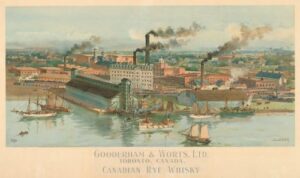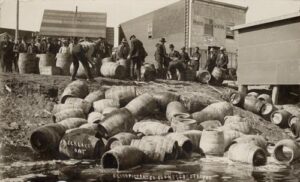As Canada prepares to celebrate its national day, Canada Day, on July 1st, its worth exploring the rich history of whisky in the country. While Canada Day commemorates the formation of the modern Canadian nation, it is intriguing to discover that Canada’s whisky-making roots predate the existence of the country itself. With the first documented distillery being found in the late 1760s and an unknown date to when the first batch of whisky was distilled, the history of Canadian whisky is known much before then.
It is said Canadian distilling began in a Pioneer Period, around 1786, in Quebec City (Kergommeaux & Phillips, 2020). The area that we would now call Ontario had been covered with dozens of settlements during the Pioneer Period, each of which had at least one commercial distillery. Canadian distillers were known for their innovative techniques, such as continuous column distillation, which allowed for efficient production and consistent quality. These innovations propelled Canadian whisky to international acclaim. Some brands we recognize today are those from the Pioneer Period that newer distilleries were able revitalize.

Figure 1: Gooderham & Worts LTD, Toronto, Canada: Canadian Rye Whisky
A Whisky Legacy Before Confederation:
Before Canada officially became a confederation in 1867, whisky production was already thriving on Canadian soil. The origins of Canadian whisky can be traced back to the late 18th century, when Scottish and Irish immigrants brought there distilling expertise to the vast landscapes of what is now Canada. These early whisky pioneers began distilling spirits using local grains, including rye, corn, barley and wheat, which great abundantly across the country. English immigrant, John Molson, would buy an old copper pot still in 1801 that would turn out to be Canada’s first known whisky still (Kergommeaux, 2017). The largest single-source of revenue for the country would be the tax on alcoholic beverages up to 1848.
Prohibition and Resilience:
The Prohibition era began after the war ended in 1918 and would have a significant impact on the Canadian whisky industry. The Temperance Act would be introduced in 1878 and give governments the power to ban the sale of alcohol that would continue all the way up to 1916, that led to the prohibition of alcohol in Ontario, Canada (Decarie, 2013). Although Canada’s Prohibition era did not last as long as the Prohibition in the United States, it still had a significant impact on the nation’s alcohol consumption and production, resulting in illegal smuggling operations.

Figure 2: A liquor raid at Elk Lake, Ontario, 1925. Illegal production of liquor wasn’t a problem before regulation.
Modern Revival and Craft Distilling:
In recent years, there has been a resurgence of interest in Canadian whisky, fueled by a growing appreciation for its rich heritage and craftmanship. Distilleries across Canada, both large and small, are producing an impressive range of whiskies, exploring traditional methods while also pushing the boundaries of innovation. This resurgence has resulted in a diverse array of expressions, showcasing the depth and complexity of Canadian whisky.
Canada Day is an ideal time to honour and celebrate the rich whisky heritage and acknowledge our nation’s whisky making that existed in Canada before the nation itself. The story of Canadian whisky is one of resilience, innovation and the pursuit of excellence. In the festivities of Canada Day, raise a glass and appreciate the unique flavours and traditions that have shaped this beloved Canadian spirit. Cheers to Canada’s whisky heritage, pre-dating the very nation we proudly celebrate.
References
Decarie, G. (2013, July 23). Temperance Movement in Canada. Retrieved from The Canadian Encyclopedia: https://www.thecanadianencyclopedia.ca/en/article/temperance-movement#:~:text=The%20Canada%20Temperance%20Act%20(Scott,ban%20the%20sale%20of%20alcohol.
Kergommeaux, D. D. (2017). Canadian Whisky: The Portable Expert. Appetite by Random House.
Kergommeaux, D. d., & Phillips, B. (2020, August 31). Canadian Whisky in Three Periods. Retrieved from Distilling: https://distilling.com/distillermagazine/canadian-whisky-in-three-periods/
Russell, E. (n.d.). Canada’s Boozy History . Retrieved from Cranbrook History Centre: https://www.cranbrookhistorycentre.com/canadas-boozy-history/

